Looking to take a different approach with your high school students in helping them develop a love of learning through writing? Here is a list of the best books for teaching high school writing that will give you the strategies and inspiration to help students develop curiosity, joy, and critical thinking skills.
By Kerry L. Mess
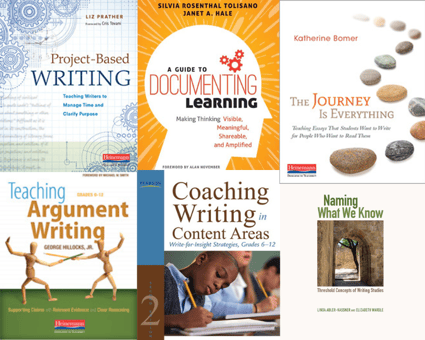
Writing for Learning and the Love of It
“…up until around a week ago I had never found much joy doing research for an essay and inputting information from a source into my writing. That is until I wrote my first essay in my college writing class… it was the first time I had a feeling of joy and wasn’t just ‘getting it over with'" (College English student reflection essay)
How do we reclaim writing as exploration and joy for ourselves and our scholar students?
When I had my college freshmen make a learning list—at least ten things I want to learn about that are not part of my major or program—I encouraged a certain wildness: What are you honestly curious about but never had the time learn about regardless of whether or not it’s a school subject?
This list became the source for the first expository essay topic, which they had to pitch to the class. Many scholars noted this as a major change from high school: a sudden freedom in their writing. They no longer felt caged by prescriptions and “dead” assignments that felt like busy work. In my world, this is success, which I attribute to three indispensable sets of texts that have helped me reclaim joy in the teaching and learning of writing for me and my scholars.
Books for Renewing Purpose and Vision for Writing
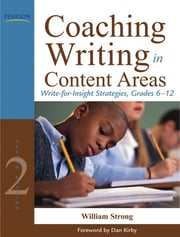 William Strong’s Coaching Writing in Content Areas: Write-for-Insight Strategies, Grades 6-12 (Pearson, 2012) is a great place to start. Strong challenges what he calls “the hidden curriculum of writing,” those disempowering school [experiences] resulting in undesired learning, and organizes solutions around pedagogical concerns such as designing assignments and rubrics, managing the writing process, and coaching and judging writing.
William Strong’s Coaching Writing in Content Areas: Write-for-Insight Strategies, Grades 6-12 (Pearson, 2012) is a great place to start. Strong challenges what he calls “the hidden curriculum of writing,” those disempowering school [experiences] resulting in undesired learning, and organizes solutions around pedagogical concerns such as designing assignments and rubrics, managing the writing process, and coaching and judging writing. Each topic includes relevant classroom activities that use writing as a vehicle for thinking and a tool for learning rather than a chore to complete. Chapters end with “Write-for-Insight” activities that encourage educators to engage with the chapter’s pedagogy and activity ideas.
While each chapter contains immediately usable gems, Strong’s focus on resisting school’s hidden curriculum of writing provides a powerful lens for understanding and pathways for dismantling destructive writing practices while building students’ writing muscles.
>> Also read 30+ Creative Writing Prompts for High Schoolers for relevant writing exercises for students.
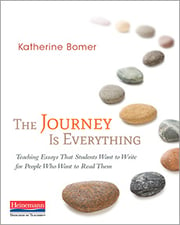 Katherine Bomer’s title, The Journey Is Everything: Teaching Essays That Students Want to Write for People Who Want to Read Them (Heinemann, 2016), says it all. Framing the journey, Bomer first informs our vision of essay, returning us to Montaigne’s notion of trying on ideas through writing (“essais-ing”). Bomer then translates Montaigne’s vision into practical reality with classroom activities and applications to academic writing.
Katherine Bomer’s title, The Journey Is Everything: Teaching Essays That Students Want to Write for People Who Want to Read Them (Heinemann, 2016), says it all. Framing the journey, Bomer first informs our vision of essay, returning us to Montaigne’s notion of trying on ideas through writing (“essais-ing”). Bomer then translates Montaigne’s vision into practical reality with classroom activities and applications to academic writing.With guest essays and mentor text resources, Bomer’s book provides incredible and breathtaking tapestries of beauty to weave into classroom practice. A single guest essay awed my high school juniors into imagining new possibilities for approaching the literary analysis essay as a work of art. This book is a gift for all those who dread the hidden curriculum’s logical consequence, thoughtless or care-less student writing.
Books to Help You Empower Writers
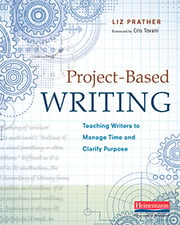 Liz Prather’s Project-Based Writing: Teaching Writers to Manage Time and Clarify Purpose (Heinemann, 2017) focuses on “writing readiness” for college. Like Bomer, Prather demonstrates making writing “real” both for students and their audiences. Prather takes a community-centric approach to writing. She provides practical pathways and step-by-step processes to engage either in small bits of project-based writing or from beginning to end: pitching writing ideas, creating goals and schedules for writing projects, managing studio writing time, generating inquiry questions, engaging in say-back sessions for feedback and revision, and final reflecting and responding.
Liz Prather’s Project-Based Writing: Teaching Writers to Manage Time and Clarify Purpose (Heinemann, 2017) focuses on “writing readiness” for college. Like Bomer, Prather demonstrates making writing “real” both for students and their audiences. Prather takes a community-centric approach to writing. She provides practical pathways and step-by-step processes to engage either in small bits of project-based writing or from beginning to end: pitching writing ideas, creating goals and schedules for writing projects, managing studio writing time, generating inquiry questions, engaging in say-back sessions for feedback and revision, and final reflecting and responding.Recently, an English professor asked me what I did to get my 8 a.m. College English students so engaged; she had passed by when they were pitching ideas for their first essay. The professor has since borrowed the book for her own writing classes. If you’re looking for clear, adaptable activities to put students in charge of their writing, look no further.
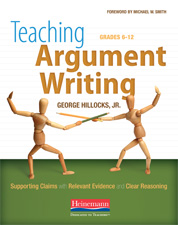 George Hillocks Jr.’s Teaching Argument Writing, Grades 6-12: Supporting Claims with Relevant Evidence and Clear Reasoning (Heinemann, 2011) is a perfect companion to Prather’s text. I have always found teaching students to make a claim and find evidence to support it relatively easy, but teaching them to explain their thinking is most challenging.
George Hillocks Jr.’s Teaching Argument Writing, Grades 6-12: Supporting Claims with Relevant Evidence and Clear Reasoning (Heinemann, 2011) is a perfect companion to Prather’s text. I have always found teaching students to make a claim and find evidence to support it relatively easy, but teaching them to explain their thinking is most challenging.In the first half, Hillocks Jr. distinguishes three types of argument—fact, judgment, policy—and provides engaging activities that show students how to build thinking for an argument and how to analyze and explain evidence to support a claim. The second half examines real-world applications for more complex arguments, including how to teach literary analysis to actually develop students’ appreciation of literature.
I have watched ninth graders through college freshmen engrossed in Hillocks Jr.’s activities; their passion in questioning and challenging texts and each other to build arguments through thorough analysis and explanation affirms the soundness of Hillocks Jr.’s pedagogy. The introduction, “Planning for Powerful Learning,” summarizes the possibilities: Students will never forget the learning they gain through activities in this text.
Books to Think About the Big Picture: Philosophy for Learning, for Life
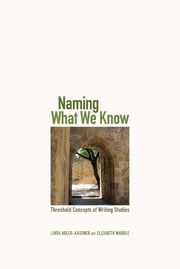 Naming What We Know: Threshold Concepts of Writing Studies, edited by Linda Adler-Kassner and Elizabeth Wardle (University Press of Colorado, 2015), provides a philosophical and practical antidote to the hidden curriculum of writing Strong identifies. Editors compile five overarching conceptions about writing that, once internalized, have the power to transform writers, opening new possibilities for their relationship with and engagement in writing. The second half of the book examines how to use threshold concepts.
Naming What We Know: Threshold Concepts of Writing Studies, edited by Linda Adler-Kassner and Elizabeth Wardle (University Press of Colorado, 2015), provides a philosophical and practical antidote to the hidden curriculum of writing Strong identifies. Editors compile five overarching conceptions about writing that, once internalized, have the power to transform writers, opening new possibilities for their relationship with and engagement in writing. The second half of the book examines how to use threshold concepts.While focused primarily on college education, the concepts presented provide a shift away from the hidden curriculum of writing and types of knowledge to a more generative stance focused on types of thinking.
I have pages of notes from insights gained while reading; like Strong’s work, this text provokes reflection and challenges our writing sensibilities.
>> Also check out creative writing mini lessons for high school students.
 Nothing kills learning like a focus on grades. Silvia Rosenthal Tolisano and Janet A. Hale’s A Guide to Documenting Learning: Making Thinking Visible, Meaningful, Shareable, and Amplified (Corwin, 2018) provides a much-needed road map to shifting the focus of school (and writing!) from grades to learning. Working from the premise that learning and documenting—like writing—are ongoing and non-linear processes, Tolisano and Hale explore three ways to document learning while differentiating documenting from assessing.
Nothing kills learning like a focus on grades. Silvia Rosenthal Tolisano and Janet A. Hale’s A Guide to Documenting Learning: Making Thinking Visible, Meaningful, Shareable, and Amplified (Corwin, 2018) provides a much-needed road map to shifting the focus of school (and writing!) from grades to learning. Working from the premise that learning and documenting—like writing—are ongoing and non-linear processes, Tolisano and Hale explore three ways to document learning while differentiating documenting from assessing.They explain pedagogical engagement (what educators do) and heutagogical engagement (what learners do) to document rather than display learning. Like Prather’s book, this text focuses on putting students in charge of their learning and on students and educators learning side-by-side.
The diagrams and charts make the concepts of and about documenting learning visible, meaningful, and shareable. Bonus items attached to QR codes spread throughout the book demonstrate how to amplify learning beyond a single student and a single teacher or classroom.
A local high school science teacher keeps asking for a second book study on this text to further his exploration and experimentation, a testament to this book’s merit for practical approaches to facilitating learning.
I continue to consult these six texts regularly while planning how to teach writing, and they never fail to reward.
About Kerry L. Mess
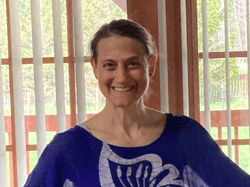 National Board-certified high school English teacher Kerry L Mess began teaching at 2½ when her sister was born. She trained English teachers in Sri Lanka (Peace Corps) for four years, writing a book for and with her teacher students. Post-Peace Corps, Kerry taught English for 21 years in Milwaukee. She spent the pandemic shutdown becoming intimately acquainted with and using Write the World for students. Uprooted from her Milwaukee home, she completed a master’s in Communication and Rhetorical Studies at Syracuse University (May 23) where she taught presentational speaking and earned a Certificate in University Teaching and the Graduate School’s Outstanding TA Award. She is currently teaching College Writing at Hartwick College in Oneonta NY as she discerns what’s next in her life path. Contact her at klmess@syr.edu.
National Board-certified high school English teacher Kerry L Mess began teaching at 2½ when her sister was born. She trained English teachers in Sri Lanka (Peace Corps) for four years, writing a book for and with her teacher students. Post-Peace Corps, Kerry taught English for 21 years in Milwaukee. She spent the pandemic shutdown becoming intimately acquainted with and using Write the World for students. Uprooted from her Milwaukee home, she completed a master’s in Communication and Rhetorical Studies at Syracuse University (May 23) where she taught presentational speaking and earned a Certificate in University Teaching and the Graduate School’s Outstanding TA Award. She is currently teaching College Writing at Hartwick College in Oneonta NY as she discerns what’s next in her life path. Contact her at klmess@syr.edu.





